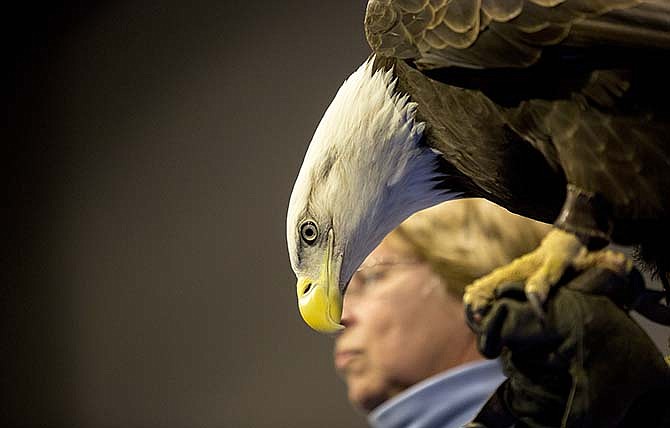A group of 200 children and parents collectively oohed and awed as they observed the scale and sound of two live eagles Saturday morning at the Runge Conservation Nature Center in Jefferson City.
Cameras flashed and the audience gasped as the large birds were brought from their covered cages. The handlers kept them secure with proper gear as to not endanger the spectators, but still, when one of the birds of prey fluttered its wings, the breeze could be felt almost anywhere in the room.
"We have three live eagle programs going on today and they are being presented by
Dickerson Park Zoo out of Springfield," said Kathy Cavender, manager of the center. "And in the lobby here we have three different activities that people can be involved with, a couple of crafts, and an activity where kids try to make an eagle nest out of twigs. ... outside we have actually an eagle's nest and a place where kids can work to build a eagle's nest to the actual size and then they can see how big their wing span is compared to an eagle's."
Also in the lobby of the nature center, the naturalist from Missouri Department of Conservation (MDC) had information about other raptors, or birds of prey, like hawks, owls and falcons. They had a grip tester to compare individual's grip to that of an eagle, which can grip up to 400 pounds per square inch. The record for an MDC employee's grip strength was just more than 150.
"Golden eagles and bald eagles are considered raptors, or birds of prey," said Becky Matney, naturalist with the MDC. "So they have three characteristics that classify them as raptors, and that is keen eyesight, your strong beak and your sharp beak, and your strong and sharp talons."
Just down the hall in the auditorium, people were getting closer to a bald eagle than they may ever be again. The two handlers from the zoo had a golden eagle and a bald eagle. The bald eagle is a resident bird in Missouri thanks to conservation and repopulation efforts, whereas the golden is not. But golden eagles migrate through the state in the winter, and are commonly mistaken for young bald eagles that have not gotten their white feathers yet.
The golden eagle is on the Mexican flag and quite different from its technically hairless counterpart. They hunt small mammals and reptiles, and bald eagles tend to enjoy fish. This is why bald eagles tend to nest closer to rivers or streams, and golden eagles like vast open land such as prairies. Golden eagles are also slightly smaller than bald eagles.
"They are very interesting, beautiful, lovely, awesome creatures. ... I just think they are majestic," Matney said. "I think it is interesting that their grip can exert up to 400 pounds per square inch of pressure and they could actually crush a softball or a baseball. Another interesting fact about them is that most people think they are excellent hunters, and they are, but they tend to be more like scavengers. They take most of their food from food that is already dead or dying. So they are smart hunters; they know how to use their resources."
A bald eagle can grow to more than 15 pounds with a wing span as large as eight feet, according to information from the MDC. They have razor sharp talons and can see five to six times sharper than humans. This eyesight is not compromised when they dive hundreds of feet from the sky at speeds of more than 100 miles per hour for prey, because of their nictitating membrane, or second set of eyelids, and their ridged eyebrows that help them aerodynamically as well as optometrically in a speedy descent.
Bald eagles were common in Missouri in the 1800s, but by 1890 they were nearly eliminated as nesters. The use of pesticides such as DDT also harmed the reproductive rates of the eagles, causing the population in Missouri to be gone in the mid-1900s.
The MDC partnered with the Dickerson Zoo and the U.S. Fish and Wildlife Association to release 74 young bald eagles into Missouri between 1981 and 1990 to help reestablish them as nesters. And now, more than 2,000 bald eagles are reported in Missouri during winter months, making this state one of the leaders in bald eagle populations in the lower 48, according to MDC.


